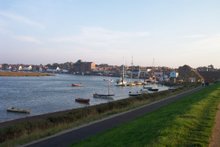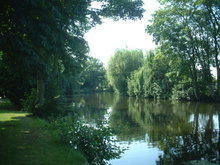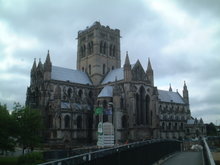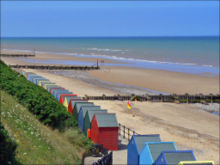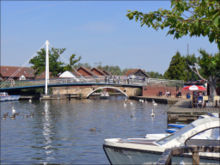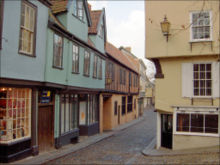Norfolk
2007 Schools Wikipedia Selection. Related subjects: Geography of Great Britain
| Norfolk | |
|---|---|
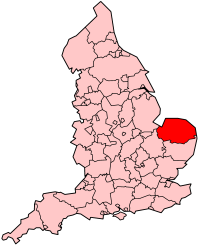 |
|
| Geography | |
| Status: | Ceremonial & Non-metropolitan county |
| Region: | East of England |
| Area: - Total - Admin. council |
Ranked 5th 5,371 km² Ranked 5th |
| Admin HQ: | Norwich |
| ISO 3166-2: | GB-NFK |
| ONS code: | 33 |
| NUTS 3: | UKH13 |
| Demographics | |
| Population: - Total (2005 est.) - Density - Admin. Council |
Ranked 24th 824,200 153 / km² Ranked 7th |
| Ethnicity: | 98.5% White |
| Politics | |
 Norfolk County Council http://www.norfolk.gov.uk/ |
|
| Executive: | Conservative |
| Members of Parliament | |
|
Richard Bacon, Henry Bellingham, Charles Clarke, Christopher Fraser, Ian Gibson, Norman Lamb, Keith Simpson, Anthony Wright |
|
| Districts | |
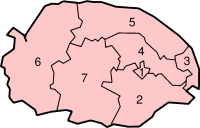
|
|
Norfolk (pronounced IPA: [ˈnɒːfək]) is a low-lying county in East Anglia in the east of southern England. It has borders with Lincolnshire to the west, Cambridgeshire to the west and southwest and with Suffolk to the south. Its northern and eastern boundaries are the North Sea coast, including The Wash. The county town is Norwich, located at . Norfolk is the fifth largest ceremonial county in England, with an area of 5,371 sq km (2,074 sq mi).
Of the 34 non-metropolitan English counties, Norfolk is the seventh most populous, with a population of 816,500. However, as a largely rural county it has a low population density, 152 people per square kilometre, making it 25th highest by population density. This is reflected in Norfolk's economy which is dominated by agriculture and tourism. The Broads lie partly within the county. A recent bid to have them declared a National Park failed, because it would have meant conservation being more important than navigation. Historical sites, such as the centre of Norwich, also contribute to tourism.
In a contest held by Plantlife, Norfolk's county flower was voted to be the Common Poppy after complaints that the first choice Alexanders was not representative.
History
Norfolk was settled in pre-Roman times, with neolithic camps along the higher land in the west where flints could be quarried. A Brythonic tribe, the Iceni, inhabited the county from the first century BCE, to the end of the first century CE. The Iceni revolted against the Roman invasion in 47 CE, and again in 60CE led by Boudica. The crushing of the second rebellion opened the county to the Romans. During the Roman era roads and ports were constructed throughout the county and farming took place.
Situated on the east coast, Norfolk was vulnerable to invasions from Scandinavia and northern Europe, and forts were built to defend against the Angles and Saxons. By the 5th century the Angles, for whom East Anglia and England itself are named, had established control of the region and later became the "north folk" and the "south folk", hence, "Norfolk" and "Suffolk". Norfolk, and several adjacent areas, became the kingdom of East Anglia, later merging with Mercia and then Wessex. The influence of the Early English settlers can be seen in the many "thorpes", "tons" and "hams" of placenames. In the 9th century the region again came under attack, this time from Vikings who killed the king, Edmund the Martyr. In the centuries before the Norman Conquest the wetlands of the east of the county began to be converted to farmland, and settlements grew in these areas. Migration into East Anglia must have been high, as by the time of the Conquest and Domesday Book survey, it was one of the most densely populated parts of the British Isles.
During the high and late Middle Ages the county developed arable agriculture and woolen industries. The economy was in decline by the time of the Black Death, which dramatically reduced the population in 1349. By the 16th century Norwich had grown to become the second largest city in England, but in 1665 the Great Plague of London again killed around one third of the population. During the English Civil War Norfolk was largely Parliamentarian. The economy and agriculture of the region declined somewhat, and during the industrial revolution Norfolk developed little industry and was a late addition to the railway network.
In the 20th century the county developed a role in aviation. The first development in airfields came with the First World War; there was then a massive expansion during the Second World War with the growth of the Royal Air Force and the influx of the American USAAF 8th Air Force which operated from many Norfolk airfields. During the Second World War agriculture rapidly intensified, and has remained very intensive since with the establishment of large fields for cereal and oil seed rape growing. Norfolk's low-lying land and easily eroded cliffs, many of which are chalk and clay, make it vulnerable to the sea, the most recent major event being the North Sea flood of 1953.
Physical geography
Geologically Norfolk can be divided into three regions. In the east the county lies on weak pliocene (1.8-5.3mya) rocks which form low, flat land easily eroded by the sea. Fossils in these rocks document over a million years of climate fluctuations. To the west is a stronger band of Chalk (70-100mya) which dips to the north and in places has a unique red colour. The chalk is part of the Southern England Chalk Formation which is also found in Salisbury Plain, the South Downs and Isle of Wight, though in Norfolk it doesn't form as high hills as to the south. In the far west of county the landscape is again low, flat and wet, around The Wash, a large inlet eroded into the weak rock. The transition between the eastern and western geology can be seen clearly at Weybourne, where the coastline suddenly changes.
Much of Norfolk, like surrounding East Anglian counties, is low lying and close to sea level. The Norfolk Broads are an important wetland habitat and tourist attraction, part of The Broads statutory area which has similar status to a National Park. Another important habitat is Thetford Forest Park, a coniferous forest and heathland park. Some of the county, like neighbouring Cambridgeshire, is used for intensive arable agriculture and is crossed by artificial drainage canals.
The highest point of the county is Beacon Hill at 105m. It is the highest point of the Cromer Ridge, a ridge of old glacial moraines that stands next to the coast above Cromer.
Being in the east, sheltered from most of the extreme weather of the Atlantic, Norfolk has amongst the lowest rainfall in the UK, at 466-641 mm (18-25 in). The area has mean temperatures of between 9.4 and 10.1 degrees celsius (approx 50 degrees fahrenheit), second only to South West and South East England. With between 1471 and 1885 hours of sunshine annually, it is behind only the south-coast counties and Suffolk
Economy and industry
In 1998 Norfolk had a Gross Domestic Product of £9,319 million, making it 1.5% of England's economy and 1.25% of the United Kingdom's economy. The GDP per head was £11,825, compared to £13,635 for East Anglia, £12,845 for England and £12,438 for the United Kingdom. In 1999-2000 the county has an unemployment rate of 5.6%, compared to 5.8% for England and 6.0% for the UK.
Much of Norfolk's flat and fertile land has been drained and converted to arable land. Over 20% of employment in the county is in the agriculture and food industries. Agribusiness has been successful in the county, and farming is very intensive with large fields, and many formerly family-run farms have been agglomerated into large farms which are highly efficient but criticised for reducing biodiversity and employment.
Politics
Norfolk County Council is Conservative-controlled, with 46 Conservative councillors, 22 Labour councillors, 14 Liberal Democrat councillors and two Green councillors. There was 63% turnout at the most recent local election.
In the House of Commons, Norfolk is represented by four Conservative Members of Parliament, three Labour MPs and one Liberal Democrat. Labour represent the more urban areas of Norwich and Great Yarmouth. The former Home Secretary, Charles Clarke, represents Norwich South.
| Parliamentary | County Council | ||||||||
|---|---|---|---|---|---|---|---|---|---|
| Party | Votes | Votes % | Seats | Seats % | Party | Votes | Votes % | Seats | Seats % |
| Conservative | 163224 | 40% | 4 | 50% | Conservative | 158942 | 39% | 46 | 55% |
| Labour | 122650 | 30% | 3 | 38% | Green | 18786 | 5% | 2 | 2% |
| Liberal Democrat | 103805 | 25% | 1 | 13% | Labour | 108043 | 27% | 22 | 26% |
| Others | 19371 | 5% | 0 | 0% | Liberal Democrat | 113048 | 28% | 14 | 17% |
| Others | 6924 | 2% | 0 | 0% | |||||
| Totals | 409050 | 8 | 405743 | 84 | |||||
| Turnout | 64% | 63% | |||||||
| Notes | |||||||||
| Includes Town Close ward by-election held 26th May 2005, electors in Town Close didn't vote for a County Councilor on 5th May 2005 due to the death of one of the candidates between close of nominations and polling day. | |||||||||
| UKIP, Green, LCA, Independents, Others | |||||||||
| UKIP, LCA, Independents, Others | |||||||||
Settlements and communications
Norfolk's county town and only city is Norwich, one of the largest settlements in England during the Norman era. Norwich is home to Norfolk's only university, the University of East Anglia, and is the county's main business and culture centre. Other principal towns include the port-town of King's Lynn and the seaside resort and Broads gateway town of Great Yarmouth. There are also several market towns: Aylsham, Downham Market, Fakenham, Holt, Swaffham, Thetford and Wymondham.
Norfolk is one of only four non-metropolitan counties in England that does not have a motorway. The A11 connects Norfolk to Cambridge and London and the A47 runs west to the East Midlands. The Great Eastern Main Line is a major railway from London Liverpool Street Station to Essex, Suffolk and Norfolk. The only major airport in the county is Norwich International Airport, which offers flights within Europe, including a link to Amsterdam which offers onward flights throughout the world.
Dialect, accent and nickname
The Norfolk Dialect also known as "Broad Norfolk" is the accent/dialect of people living in Norfolk, although over the modern age, a lot of the vocabulary and phrases have died out due to a number of factors such as radio, TV and people from other parts of the country coming to Norfolk. As a result the speech of Norfolk is more of an accent than dialect though one part retained from the Norfolk dialect is the distinctive grammar of the region.
Most English counties have nicknames for people from that county, such as a Tyke from Yorkshire and a Yellowbelly from Lincolnshire; the traditional nickname for people from Norfolk is 'Norfolk Dumpling' or 'Norfolk Pudden' ("pudding"): two of the county's two culinary dishes.
More cutting, perhaps, is the medical slang term Normal for Norfolk.
Tourist highlights
Norfolk is a popular tourist destination; major attractions include beaches, the Broads, and the city of Norwich. Rural parts of the county, notably the area around Burnham Market, are also popular locations for city dwellers to purchase weekend homes.
People of Norfolk
Here are some notable people who were born and/or raised in Norfolk:
- Boudica, queen of the Iceni people in ancient Britain and scourge of the occupying Roman Army, was born in the part of Norfolk that is close to Norwich, at a settlement near the River Wensum
- Cathy Dennis, the singer and songwriter, hails from Norwich
- Anthony Duckworth-Chad, landowner and Deputy Lord Lieutenant of Norfolk
- Sir James Dyson, the inventor and entrepreneur, grew up at Holt and was educated at Gresham's School
- Stephen Fry, Actor, comedian, writer, producer, director and author. Was born in London and was brought up in the village of Booton near Reepham and also briefly attended Gresham's.
- Claire Goose, the actress who starred in Casualty, was raised in Norfolk
- Sienna Guillory, the actress, hails from north Norfolk and was educated at Gresham's School
- Ed Graham, drummer of Lowestoft band The Darkness, was born in Great Yarmouth
- Sid Kipper, Norfolk humourist, author, songwriter and singer
- Myleene Klass, former Hear'Say singer, hails from Gorleston
- Matthew Macfadyen, the actor who starred in Spooks, was born in Great Yarmouth
- Lord Nelson was born in Burnham Thorpe and bred in Norfolk
- Thomas Paine, philosopher, born in Thetford
- Philip Pullman, author, born in Norwich
- Allan Smethurst, 'The Singing Postman' who sang songs in his Norfolk dialect, was from Sheringham
- Thomas Shadwell, playwright, satirist and poet laureate.
- Hannah Spearritt, actress and former S Club 7 singer, is from Gorleston
- Peter Trudgill, sociolinguist on accents and dialects including his own native Norfolk dialect, was born and bred in Norwich
- Robert Walpole, regarded as the first British prime minister
- Beth Orton, award-winning singer/songwriter, was born in Dereham
- Delia Smith, British TV cook and major Norwich City Football Club shareholder
- John Wilson, angler
- Diana Spencer, first wife of Charles, Prince of Wales, was born and grew up near Sandringham
- Martin Brundle, former motor-racing driver and now popular commentator was born in King's Lynn
- Dave Bussey Former BBC Radio 2 and current BBC Radio Lincolnshire presenter
